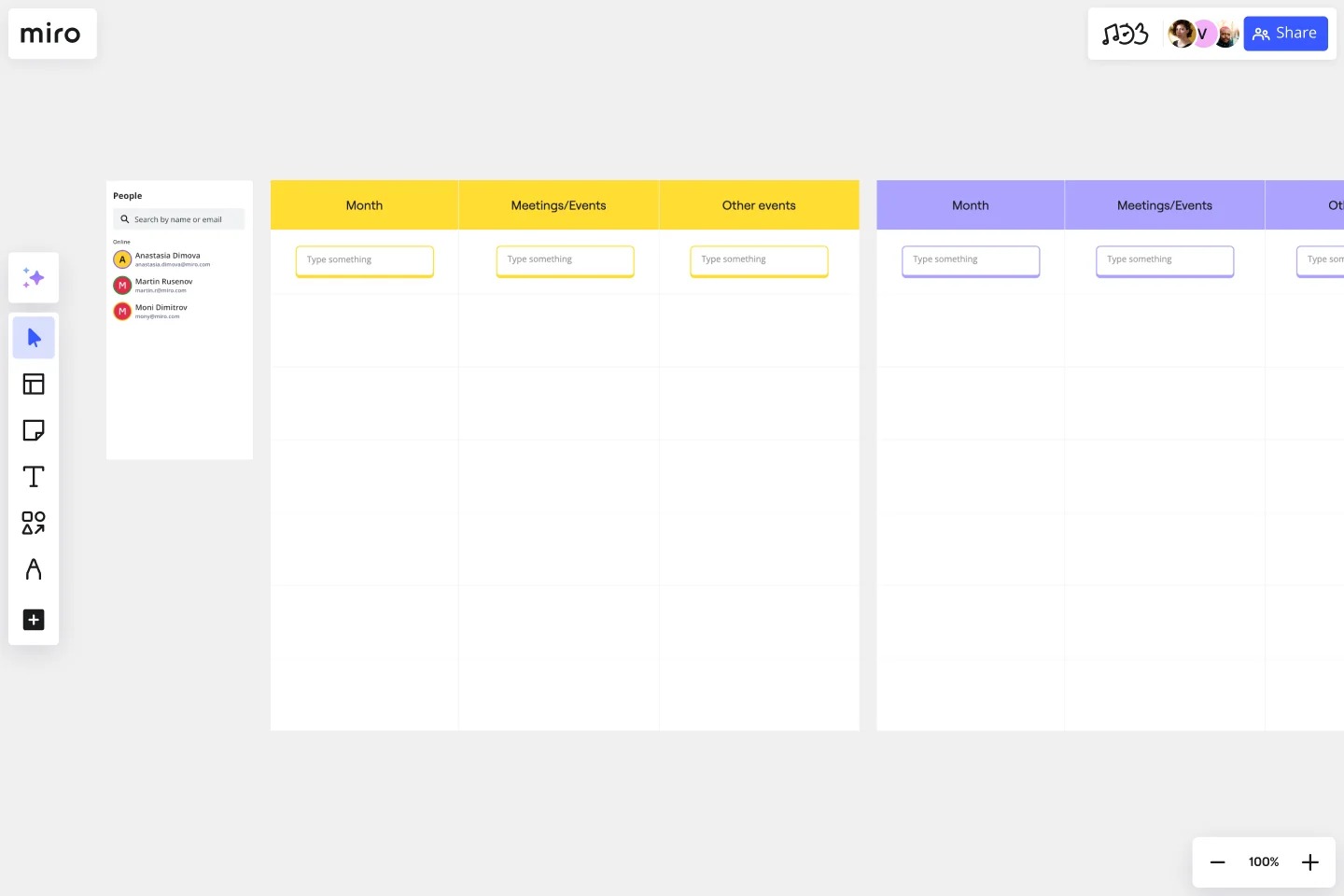Annual Event Planner Template
Streamline your event planning process with this simple yet efficient annual event planner template.
About the Annual Event Planner Template
Organizing events can be daunting, but it doesn't have to be with the help of our annual event planner template. This template is created precisely to streamline the process and ensure your events are organized efficiently and collaboratively. Whether you're coordinating monthly team meetings, major conferences, or any other significant events, this template has got you covered.
What's the annual event planner template?
The annual event planner template breaks down the year into manageable sections, helping you plan and execute various events.
Structured timeline: Our template provides a clear and structured timeline for your events by outlining each month.
Meetings/Events: This section lets you quickly detail your monthly meetings or key events. You can identify dates, topics, and participants without any hassle.
Other events: Plan and track additional events such as team-building activities, workshops, or external conferences. You can keep everything in one place for easy reference.
How to use the annual event planner template in Miro
Customizing made easy: You can effortlessly change each section by clicking and editing them. Update meeting/event details, change months, and add or remove events.
Add sticky notes: Improve collaboration by using sticky notes to add specific details, comments, or updates. You can place them directly in each field for clear communication.
Expand the template: You can seamlessly expand the template to accommodate more details or events. Drag and adjust the template boundaries to fit your requirements.
Contextual artifacts: Enhance the visual aspect of your planning by incorporating relevant artifacts on the Miro board. You can attach images, documents, or links for additional context and clarity.
Why should you use an annual event planner template?
Efficiency: Save time and streamline your planning process with a structured template that organizes all your events for the year.
Collaboration: Foster collaboration among team members by providing a centralized space for event planning, updates, and feedback.
Clarity: Ensure everyone is on the same page with a clear and detailed overview of all the events scheduled for the year.
Adaptability: Easily change dates, details, or add new events without disrupting the overall plan.
Consistency: Maintain a consistent approach to event planning, ensuring no critical details are overlooked.
Can I customize the annual event planner template for different events?
Absolutely! The template is flexible, allowing you to tailor it to various events, from team meetings to large conferences.
How do I invite team members to collaborate on the event plan?
Share the Miro board with your team via link, and they can easily access and contribute to the event planning in real-time.
Is it possible to track progress and updates within the template?
Yes, use the sticky notes and comments feature to track progress, updates, and discussions directly within the template.
Can I export the event plan for offline use or to share with stakeholders?
Miro allows you to export your boards in various formats, making it easy to share or reference the event plan offline.
Get started with this template right now.
Strategic Technology Roadmap Worksheets
Works best for:
Roadmap, Planning, Mapping
We all know that technology commercialization success starts with the end in mind, a product with market viability.
Conversion Funnel Backlog Template
Works best for:
Decision Making, Product Management, Prioritization
If you’re working on a product that has clear conversions, then it can help to structure your backlog around the conversion funnel to make sure you’re reaching your audience. Creating a conversion funnel backlog brings together information around potential pain-points in your funnel and opportunities for growth. Once you’ve identified that information, it becomes easier to prioritize. You and your team can use the conversion funnel backlog to focus on conversion, retention, and referral, or to tweak your workflow in more mature products.
Balanced Scorecard Template
Works best for:
Operations, Strategic Planning, Project Planning
Balanced scorecards are useful tools for understanding business performance at a glance with regard to customers, employees, business processes, and financial progress. Learn more about BSCs and create your own using Miro’s Balanced Scorecard template.
Product Evolution Canvas
Works best for:
Product Management, Planning
The Product Evolution Canvas template aids product managers in planning and executing product evolution strategies. By mapping out current product features, identifying areas for improvement, and setting evolution goals, this template guides product evolution efforts. With sections for analyzing user feedback, prioritizing enhancements, and tracking progress, it facilitates iterative product development and enhancement cycles. This template serves as a roadmap for evolving products to meet evolving customer needs and market demands.
One Page Product Strategy
Works best for:
Product Management, Planning
The One Page Product Strategy template condenses complex product strategies into concise, actionable plans. By providing a structured framework for outlining goals, target markets, and key initiatives, this template enables product teams to align on strategic objectives efficiently. With sections for defining value propositions, competitive differentiators, and success metrics, it facilitates strategic decision-making and execution. This template serves as a roadmap for driving product development efforts and achieving business objectives effectively.
Salesforce Implementation Plan
Works best for:
Roadmap, Planning, Mapping
The Salesforce Implementation Plan template offers a structured framework for planning and executing Salesforce deployment projects. By outlining key milestones, tasks, and dependencies, teams can ensure a smooth transition to the Salesforce platform. This template facilitates collaboration between IT and business teams, ensuring that implementation efforts are aligned with strategic objectives and deliver value to stakeholders.
